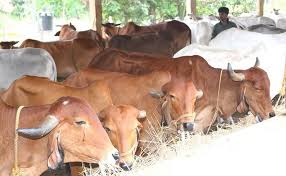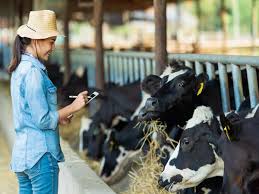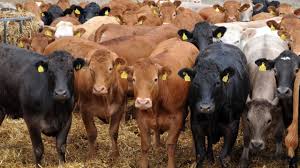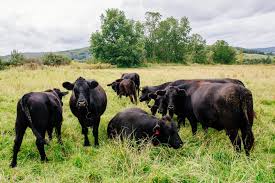Beef cattle are primarily kept for meat production, although some breeds can produce significant quantities of milk. Beef is one of the world’s most desired food products, contributing immensely to the income of nations.
The economic impact of beef enterprises is further enhanced by subsidiary industries such as transportation, marketing, feed supply, vaccines, antibiotics, and financial services that support the beef industry.
Beef cattle management includes cow-calf programs, breeding, herd management in summer and winter, stocker programs, finishing programs, baby-beef programs, fat-calf programs, and pure-breed programs.
Read Also: The Variety of Fish Body Shapes
Range Bull Management

There are various methods of acquiring range bulls, with each method fitting specific operations. Bulls are typically ready for range at 2 years of age. Managing bulls prior to the breeding season is crucial, as properly conditioned bulls should be capable of breeding 20-25 cows.
At this time, a high-energy ration must be provided and gradually reduced (‘let-down’) rather than turning the bulls out to forage.
The ‘let-down’ period involves gradually decreasing the high-energy ration and substituting lighter feed. Exercise is essential, and the gradual reduction of the high-energy ration helps the bulls perform efficiently during breeding season.
Young bulls, under 2 years old, should be used only for limited service compared to older bulls and should receive a growing ration balanced for energy, protein, vitamins, and minerals daily.
Two months before breeding, older bulls should be given increased supplemental feed to improve their condition. Bulls that are not properly conditioned before breeding season may become either too fat or too thin, leading to lower fertility or reduced libido.
The management of the bulls is influenced by the length of the breeding season. A shorter season places greater stress on the bulls.
With a ratio of 25 cows to 1 bull, a concentrated breeding season of 60 days allows only 2½ days per service, while an extended season of 120 days provides nearly 5 days per service. The number of bulls required is also dependent on the topography, age of the bulls, and the feed conditions on the range.
Cow-Calf Program

A cow’s gestation period is 280-285 days, leaving only 80-85 days from calving until she must become pregnant again to maintain a 365-day calving cycle.
Studies have shown that cows on moderate feed levels required more assistance during birth compared to cows on low feed levels. Cows on low feed levels experienced fewer calving problems and calf losses, but returned to heat more slowly after calving.
Before calving, facilities such as pull stalls and pens for the cows to ‘mother’ their calves should be provided. Identification bands should also be made available. Heifers should be separated from cows 120 days before calving to provide them with appropriate nutrition and determine expected calving dates.
After calving, a cow’s nutrient requirements increase and they should be separated from cows that have not yet calved. Nutrient needs vary depending on cow size, milk production, and climate.
Providing sufficient energy is particularly challenging as the amount of grass available varies by season. It is difficult to measure the energy intake from pasture accurately.
General Herd Management Practices

1. Removal of Bulls: After the breeding season, bulls are separated from the cows, and younger bulls are separated from older ones. Thin bulls are provided with supplemental feed, along with good forage, salt, and other minerals. Bulls are periodically treated to control flies and parasites.
2. Management of First-Calf Heifers: Special care is required for heifers calving for the first time. During their second calving, they should be grazed or fed separately from older cows since they are less aggressive and may be pushed aside during feeding. Heifers should be provided with the best grazing land to ensure adequate nutrition.
3. Calf Management: Castration is usually performed when calves are 4-10 weeks old. During this time, calves can also be branded and vaccinated. Vaccination protects calves from diseases such as blackleg and malignant edema.
Orphaned calves or calves from multiple births can be ‘grafted’ onto cows that have lost their calves or reared using artificial methods. Some cows can produce enough milk to feed twins. Colostrum, which is rich in antibodies, must be provided to ensure passive immunity and survival.
Calves can be raised on cold milk through containers with nipples and are fed fortified grain mixtures. As calves grow, their dry feed consumption increases. Commercial milk replacers and starter feeds can provide adequate nutrition if used correctly.
Calf Weaning
Weaning marks a significant nutritional and psychological change for a calf, which has spent the first 7-8 months of life closely associated with its mother for protection and nourishment. The timing of weaning is influenced by the season and management goals, whether the calves are to be kept as stockers or sent to feedlots.
Weaning involves separating calves from cows at a considerable distance, so they are out of sight and hearing range. During the first few days, calves should be confined to small areas to reduce walking and weight loss.
They should also be grouped by size and sex and protected from adverse weather conditions and predators. Calves should have access to clean water and high-quality feed.
Read Also: Fish Biology: Anatomy, Physiology, Embryology and Endocrinology
Management of Dry Beef Cows

Proper feeding is essential for dry beef cows, with their requirements varying according to age, weight, and maturity. Dry, pregnant cows require energy, protein, minerals, and vitamins in varying amounts. Herd management involves dividing the cows and heifers into groups based on their specific feed needs.
In Conclusion, the primary goal of beef cattle production is to maximize benefits over time. Effective management of beef cattle, including feeding and supervision of range bulls, cows, calves, and calf weaning, plays a crucial role in achieving this goal.
Management costs include feed, labor, land investment, cattle, and equipment. In addition to minimizing costs, successful management involves timely marketing of calves, cull cows, and bulls, as well as maintaining a productive breeding herd.
The management of beef cattle at different stages of growth is determined by their nutritional and psychological needs, as well as the herdsman’s expertise. This explains why the skills required for managing calves, weaning, and first-calf heifers differ slightly.
Do you have any questions, suggestions, or contributions? If so, please feel free to use the comment box below to share your thoughts. We also encourage you to kindly share this information with others who might benefit from it. Since we can’t reach everyone at once, we truly appreciate your help in spreading the word. Thank you so much for your support and for sharing!

